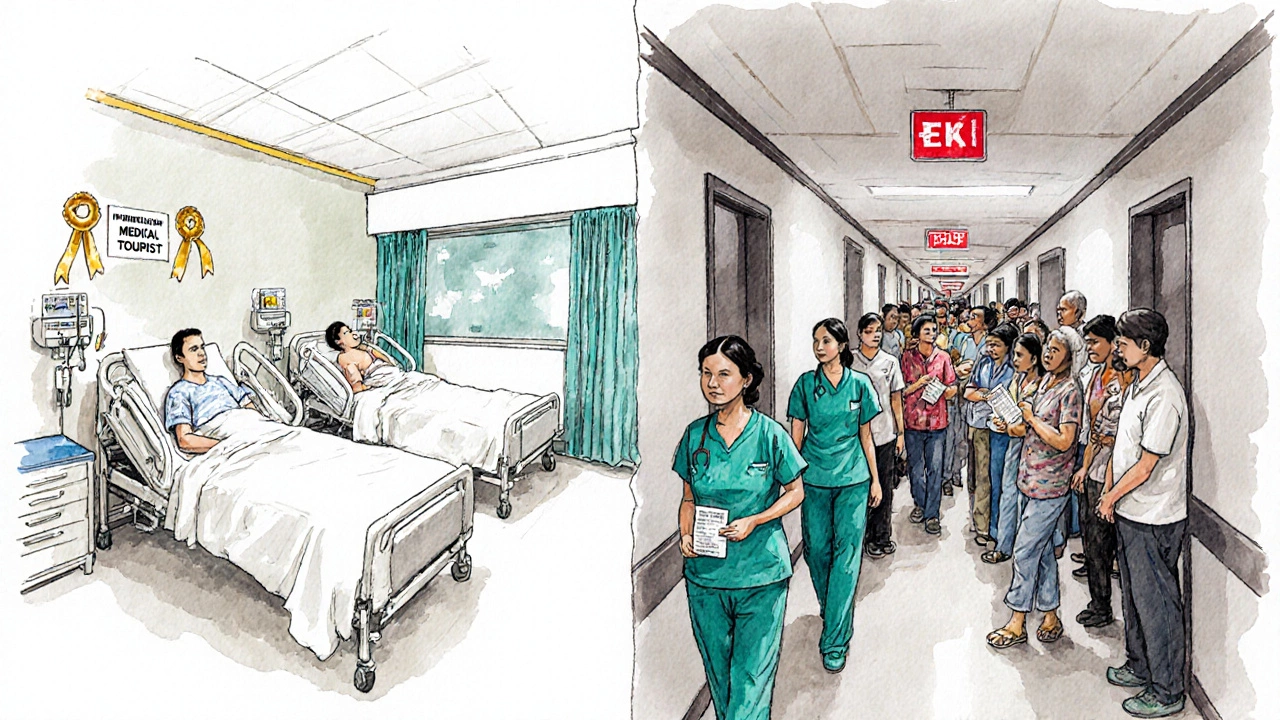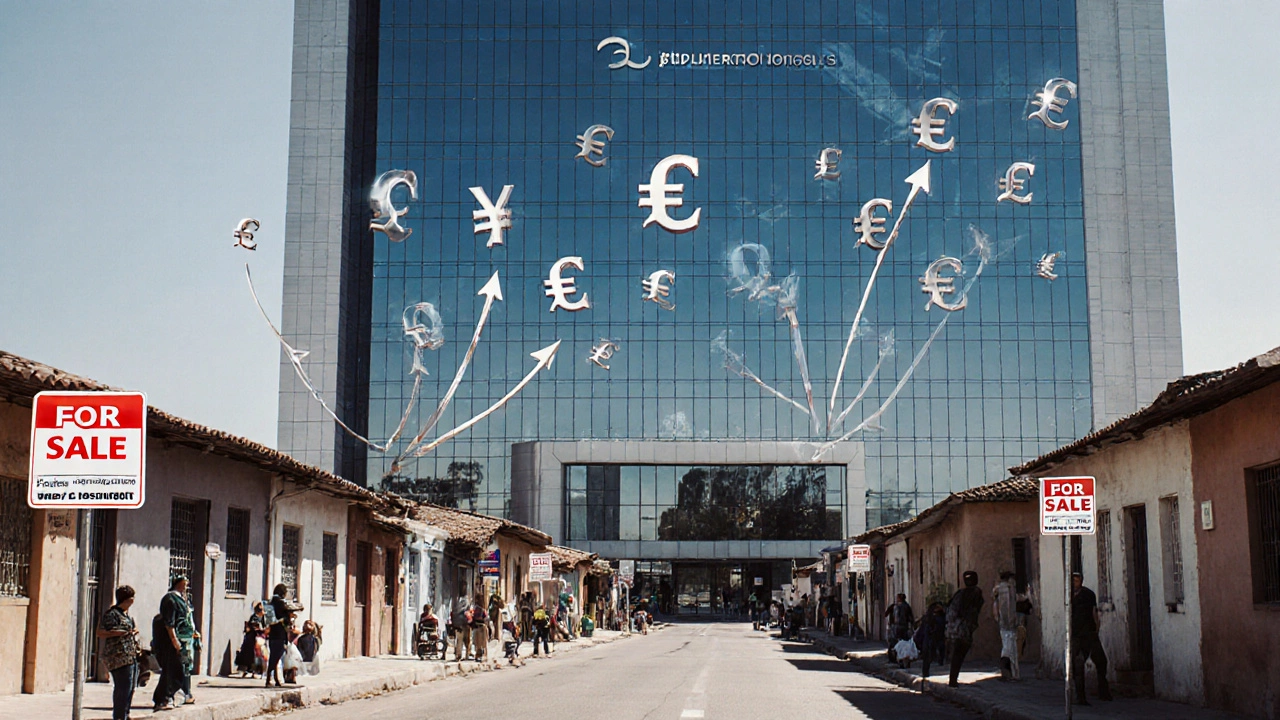Healthcare System Strain Calculator
Calculate the potential impact of medical tourism on local healthcare capacity. Input your country's ICU data to see how many residents might be affected.
Residents Affected
Up to residents may experience delayed care
Capacity Impact
Local healthcare system is of total capacity
When people travel abroad for costly procedures, the practice is called Medical tourism - a cross‑border health‑care market where patients combine treatment with travel. While it can lower costs and shorten wait times, it also brings serious downsides that affect host countries and the patients themselves. Below we break down the three most pressing negative impacts of tourism in the medical sector, backed by real‑world data and practical examples.
1. Strain on Local Healthcare Systems
Hospitals that cater to foreign patients often reserve premium beds, advanced imaging equipment, and top‑tier surgeons for paying tourists. In Thailand, for instance, private hospitals report that up to 30% of their ICU capacity is booked for medical tourists during peak seasons, leaving fewer resources for local emergencies (Thai Ministry of Public Health, 2024). This "health‑care system strain" manifests in three ways:
- Longer waiting times for residents who rely on the same facilities for routine care.
- Higher costs for locals as hospitals shift price structures to match the higher fees charged to foreigners.
- Brain drain of medical staff who are lured by higher salaries in tourist‑focused clinics, weakening public hospitals.
These effects are documented in a 2023 WHO report on health‑system resilience, which warns that unchecked medical tourism can erode universal health coverage in low‑ and middle‑income nations.
2. Environmental and Cultural Degradation
Medical tourism is a subset of the broader Overtourism phenomenon. Patients often travel with families, stay in high‑end resorts, and use private transport, amplifying the environmental footprint of a single procedure. In Costa Rica’s Guanacaste region, a surge in dental‑tourism led to over‑use of water resources and a 12% rise in solid waste generation between 2022‑2024 (Costa Rican Institute of Tourism, 2025).
Beyond ecology, cultural commodification creeps in when local traditions are packaged as "wellness experiences" for foreign patients. In India’s Kerala, Ayurvedic clinics marketed to tourists began altering traditional healing rituals to fit Western expectations, sparking backlash from local practitioners who felt their heritage was being diluted.
These patterns mirror the broader Environmental degradation and Cultural commodification trends seen in conventional tourism, but with the added pressure of high‑value, high‑frequency patient flows.

3. Economic Leakage and Inequality
While medical tourism brings foreign exchange, much of the revenue leaks out of the host economy. International chains often own the flagship hospitals, repatriating profits to shareholders abroad. A 2024 financial analysis of Mexico’s Baja California showed that only 45% of medical‑tourism income stayed within local businesses; the rest was funneled to foreign investors.
Economic leakage deepens inequality. Wealthy tourists receive premium care while local populations may face reduced access. In Brazil’s São Paulo, a study found that neighborhoods surrounding the biggest medical‑tourism hub experienced a 20% rise in property prices between 2021‑2023, pushing out low‑income families and widening the social gap.
These outcomes intersect with Patient safety concerns, as cost‑cutting measures can compromise clinical standards. The International Society for Quality in Health Care (ISQua) reported a 15% higher incidence of post‑operative infections among tourists in facilities lacking robust accreditation.
Quick Summary Table
| Impact | Description | Real‑World Example |
|---|---|---|
| Healthcare system strain | Local hospitals prioritize tourist patients, reducing capacity for residents. | Thai private hospitals allocate 30% of ICU beds to foreigners. |
| Environmental & cultural degradation | Increased waste, water use, and altered cultural practices. | Guanacaste’s water use rose 12% due to dental‑tourism. |
| Economic leakage & inequality | Profits flow abroad; locals face higher costs and displacement. | Only 45% of Baja California’s revenue stays locally. |

Mitigation Strategies for Policymakers and Providers
Addressing these challenges requires coordinated action:
- Regulatory oversight: Implement mandatory accreditation for facilities serving foreign patients and enforce local‑capacity quotas.
- Revenue‑sharing models: Require a percentage of tourist fees to fund community health clinics.
- Environmental caps: Impose waste‑management standards and limit water use for tourist‑focused centers.
- Protect cultural integrity: Involve local traditional healers in program design to avoid commodification.
- Transparent pricing: Publish comparative cost breakdowns so patients can make informed choices without sacrificing local care.
Countries like Singapore have begun piloting “dual‑track” licensing, where medical‑tourism units operate under separate management but must contribute to a national health‑care fund.
Frequently Asked Questions
Why does medical tourism strain local hospitals?
Foreign patients often pay higher fees, encouraging hospitals to allocate premium resources-such as operating rooms and specialist staff-to them. This reduces availability for residents, leading to longer wait times and, in some cases, higher out‑of‑pocket costs for locals.
Can medical tourism cause environmental harm?
Yes. The influx of patients and accompanying travelers increases waste, water consumption, and carbon emissions. In destinations where infrastructure is already stretched, this can exacerbate pollution and strain natural resources.
What is economic leakage in the context of medical tourism?
Economic leakage refers to the portion of tourism revenue that exits the host country-often through foreign‑owned hospital chains, imported medical supplies, or profit repatriation-meaning the local economy gains less than the total spend.
How can patients protect themselves when seeking treatment abroad?
Research accreditation (e.g., JCI or ISO), verify surgeon credentials, ask for detailed cost breakdowns, and check post‑procedure follow‑up support. Using a reputable medical‑tourism facilitator that offers insurance coverage can also reduce risk.
Are there any countries that have successfully mitigated these negative impacts?
Singapore’s dual‑track licensing and Thailand’s mandatory reporting of foreign patient numbers are early examples of policies aimed at balancing economic benefits with health‑system protection.
